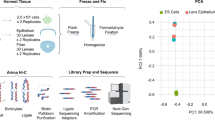Abstract
Localization, as detected by in situ hybridization, of major heterochromatic blocks in interphase nuclei of larval brain and imaginal discs is reported. We conclude that the position of heterochromatic regions in interphase nuclei is correlated with their respective position in metaphase chromosomes and hence, independent of sequence recognition. Furthermore, chromocentral associations of X-, Y- or autosomal-based heterochromatin are not formed in these cells. Homologues do align in close proximity, but heterochromatin plays no role in this arrangement. Heterochromatin, and probably nucleoli, establish their membrane links in situ, and have no prefixed recognition sites. The most intimate association between homologous repetitive sequences was found in the histone locus, but no tendency for clustering was found among loci of multisite euchromatic gene families.
Similar content being viewed by others
References
Avivi, L., Feldman, M.: Arrangement of chromosomes in the interphase nucleus of plants. Hum. Genet. 55, 281–295 (1980)
Becker, H.J.: The influence of heterochromatin, inversion heterozygosity and somatic pairing on X-ray induced recombination in Drosophila melanogaster. Molec. Gen. Genet. 105, 203–218 (1969)
Brosseau, G.E., Nicoletti, B., Gsell, E.H., Lindsley, D.L.: Production of altered Y chromosomes bearing specific sections of the X-chromosome in Drosophila. Genetics 46, 339–346 (1961)
Brown, S.W., Nur, U.: Heterochromatic chromosomes in the coccids. Science 145, 130–136 (1964)
Brutlag, D.: Molecular arrangement and evolution of heterochromatic DNA. Ann. Rev. Genet. 14, 121–144 (1980)
Chernyshev, H.I., Baskirov, V.N., Leibovitch, B.A., Khesim, R.B.: Increase in the numbers of histone genes in case of their deficiency in Drosophila melanogaster. Molec. Gen. Genet. 178, 663–668 (1980)
Comings, D.E.: Arrangement of chromatin in the nucleus. Hum. Genet. 53, 131–143 (1980)
Cooper, K.W.: Cytogenetic analysis of major heterochromatic elements (especially Xh and Y) in Drosophila melanogaster and the theory of “heterochromatin”. Chromosoma (Berl.) 10, 535–588 (1959)
Dawid, I.B., Lauth M., Wellauer, P.K.: Repetitive DNA elements related to the ribosomal insertion of Drosophila melanogaster. In: Mobilization and reassembly of genetic information (W.B. Scott, R. Werner and D.R. Joseph, eds.). Miami Winter Symp. 17, 217–234 (1980)
Hanna, A.: Localization and function of heterochromatin in Drosophila melanogaster Advanc. Genet. 4, 87–125 (1951)
Hsu, T.S.: A possible function of constitutive heterochromatin: The body-guard hypothesis. Genetics 79, 137–150 (1975)
John, B., Miklos, G.: Functional aspects of satellite DNA and heterochromatin. Int. Rev. Cytol. 58, 1–108 (1979)
Kaufman, B.P.: Organization of the chromosome. I. Break distribution and chromosome recombination in Drosophila melanogaster. J. Exp. Zool. 102, 293–320 (1946)
Korf, B.R., Gershey, E.L., Diacumakos, E.G.: Centromeres are arranged in clusters throughout the Muntjac cell cycle. Exp. Cell Res. 138, 393–395 (1982)
Lifschytz, E.: Fine structure analysis and genetic organization at the base of the X chromosome in Drosophila melanogaster. Genetics 83, 457–467 (1978)
Lifschytz, E., Hareven, D.: Heterochromatin markers: A search for heterochromatin specific middle repetitive sequences in Drosophila. Chromosoma (Berl.) 86, 429–442 (1982)
Lifton, R.P., Goldberg, M.L., Karp, R.W., Hogness, D.S.: The organization of the histone genes in Drosophila melanogaster: Functional and evolutionary implications. Cold Spr. Harb. Symp. Quant. Biol. 42, 1047–1051 (1978)
Moens, P.B., Church, K.: Centromere size, positions and movements in the interphase nucleus. Chromosoma (Berl.) 61, 41–48 (1977)
Nicoletti, B., Londsley, D.L.: Translocation between the X and the Y chromosomes of Drosophila melanogaster. Genetics 45, 1705–1722 (1960)
Pardue, M.L., Kedes, L.H., Weinberg, E.S., Birnstiel, M.L.: Localization of sequences coding for the histone messenger RNA in the chromosomes of Drosophila melanogaster. Chromosoma (Berl.) 63, 63–135 (1977)
Roberts, P.A.: In support of the telomere concept. Genetics 80, 135–142 (1975)
Rubin, G.M.: Isolation of a telomeric DNA sequence from Drosophila melanogaster. Cold Spr. Harb. Symp. Quant. Biol. 62, 1041–1046 (1978)
Spradling, A.C., Rubin, G.M.: Drosophila genome organization: Conserved and dynamic aspects. Ann. Rev. Genet. 15, 219–264 (1981)
White, M.J.D.: Animal cytology and evolution. Cambridge, Cambridge University Press 1948
Author information
Authors and Affiliations
Rights and permissions
About this article
Cite this article
Lifschytz, E., Hareven, D. Heterochromatin markers: Arrangement of obligatory heterochromatin, histone genes and multisite gene families in the interphase nucleus of D. melanogaster . Chromosoma 86, 443–455 (1982). https://doi.org/10.1007/BF00330120
Received:
Issue Date:
DOI: https://doi.org/10.1007/BF00330120




